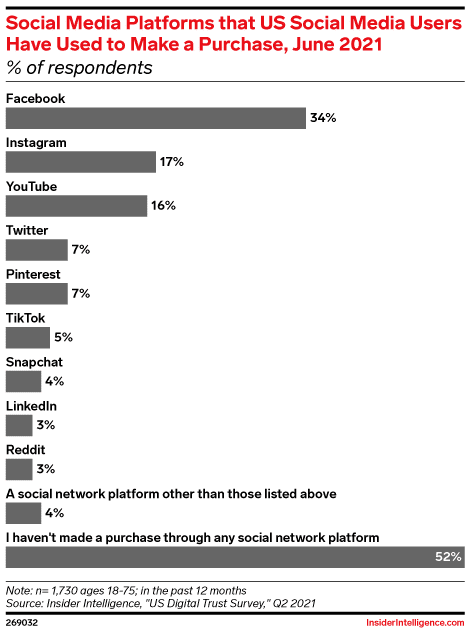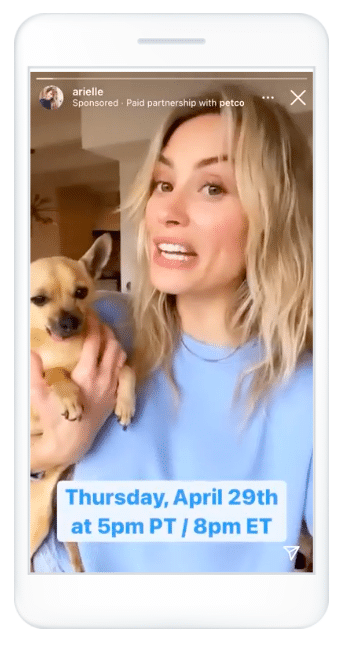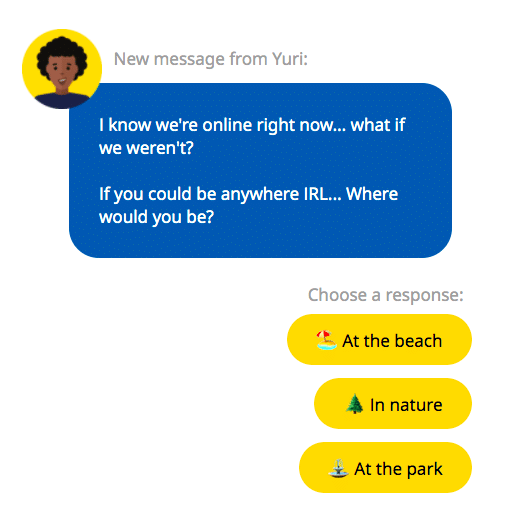Let’s talk about why it’s important to understand social media marketing for retail brands.
Nearly three-quarters (74.8%) of the world’s population over the age of 12 use social media. That’s more than 4.6 billion people, up from 1.5 billion a decade ago.
Those people are engaging with retail brands on social. Nearly a quarter (23%) of social media users follow a brand or company they already purchase from. And 21.5% follow companies and brands they’re thinking of purchasing from.
For retail brands, social commerce opens up a new pathway to purchase. But that’s not the only social media impact on retail brands. Social marketing can benefit retailers at every stage of the sales funnel.
Let’s look at how retailers use social media to build their brands and increase sales.
Bonus: Download a free guide that teaches you how to turn Facebook traffic into sales in four simple steps using Hootsuite.
1. Treat social media as part of your sales funnel
Social media is a natural place for people to do preliminary research when thinking about a purchase. More than a quarter of social media users use social platforms for “inspiration for things to do and buy.” Another 26.3% use social for “finding products to purchase.”
An even larger number of social users turn to social networks to research brands: 43.5%. Young women aged 16 to 24 are especially likely to use social for brand research.
Source: Hootsuite Global State of Digital 2022
Smaller social networks are an increasingly important way to fill your funnel. TikTok, Pinterest, and Snapchat all saw massive increases in perceived effectiveness last year.
Each social platform offers different tools and capabilities to connect with your audience and fill your sales funnel, from leads all the way through to sales. And speaking of sales…
2. Set up native social commerce solutions
Globally, social commerce is a half-trillion-dollar industry. Within the United States alone, eMarketer predicts social commerce sales of $45.74 trillion in 2022, an increase of 24.9% from the year before.
Source: eMarketer
Native social commerce solutions make it easier for social media users to buy from your retail brand, often without ever leaving the social platform. And nearly half of social media users have already done so. In fact, 34% of social media users have made a purchase through Facebook alone.
Source: eMarketer
For details on how to set up social commerce for your retail brand, check out our posts on Instagram shopping and Facebook Shops.
3. Use your social media presence for customer service
Social customer service is becoming increasingly important for brands. 59% of respondents to Hootsuite’s Social Trends 2022 survey said social customer care has increased in value for their organization.
Social messaging has replaced phone calls for many interactions with retail businesses. 64% of people said they would rather message a business than call them on the phone. And 69% of U.S. Facebook users said being able to message a business makes them feel more confident about the brand.
Gartner predicts that more than 60% of all customer service engagements will be resolved through digital or self-serve channels like social messaging and chat by 2023.
And it’s not just about brand confidence. 60% of Internet users say bad customer service is a concern when making a purchase online. Here, social media for small retailers, in particular, offers a chance to shine. Excellent customer service breaks down the barriers to purchase.
Prompt responses can be a critical factor in the purchase decision. So it’s worth investing some time and money to get social media for retail customer service right. Chatbots, conversational artificial intelligence, and tools for managing your social inbox can all help.
We’ll get into specific tools later in this post. Check out our blog post on how to provide excellent social media customer service for more tips on getting this important social media retail strategy right.
4. Work with creators
One of the best ways to connect with your audience online is to find existing communities relevant to your brand or your products or services. Creators (sometimes known as influencers) can be your way in.
Creators have a strong connection to these existing niche communities and a high level of trust from their followers. They can extend the reach of your retail brand to the social media users who are most likely to be your best customers. In fact, 84% of consumers say they would purchase, try, or recommend a product to friends and family based on relevant influencer content.
Research from Meta shows that campaigns combining influencer ads with regular social media ads are 85% more likely to result in people adding products to their shopping cart.
For specific strategies, check out our blog post on how to work with social media influencers.
5. Advertise to your target audience
Another way to laser-focus your social media efforts is to buy social ads that target your ideal retail customer.
This is one of the prime benefits of social media for retail brands. A traditional print or TV advertising campaign puts your advertising in front of many people who have no interest in your products. However, on social media, you can maximize your advertising spend by focusing your ads on the people who are most likely to convert.
So, rather than making media buys based on a publication’s overall demographic base, you can zero in on social media users based on demographics, online behavior, existing connections to your brand, location, language, and much more.
The first step is to fully understand exactly who your target audience is. Social media can help on this front, too, since it’s an excellent tool for audience research.
Once you determine who your audience is, you can determine the best strategy to align with your brand goals.
Specifically focused on increasing sales for your retail brand? you can select conversions advertising goals where you only pay per action. You can also choose ad goals to sell products from your catalog or drive customers to your brick-and-mortar store.
1. Don’t be too salesy
Yes, so far we’ve been talking all about how retailers use social media to drive more sales. But driving sales doesn’t mean being overly salesly.
Gaining new followers is an important way to increase your social reach and return on investment. But you’ll quickly lose those followers if you post nothing but promotional content.
Instead, focus on building a relationship with followers that leads to more sales over time. Use social ads to build brand awareness and drive sales. Meanwhile, your organic content builds brand loyalty and positions you as a go-to resource in your niche.
A good approach is to follow the 80-20 rule. The vast majority of your content – 80% – should entertain and inform your audience. Only 20% should directly promote your business.
2. Use social media to replicate in-store interactions
In the early days of the pandemic, in-store shopping was not an option. Ecommerce became a lifeline for everything from furniture to toilet paper, and saved the U.S. retail market from a downturn.
In 2021, ecommerce represented 15.3% of total U.S. retail sales, a figure that eMarketer predicts to grow to 23.6% by 2025. In short, shoppers who became accustomed to online shopping are continuing to purchase online even as retail stores have reopened.
That means fewer opportunities for in-person interactions with customers. Of course, those interactions are often a driver of customer loyalty and increased purchase value. In-person shopping provides a familiar brand experience. And sales associates can help customers find the right products.
Social tools allow brands to recapture some of that key personal mojo through strategies like:
- product demonstrations on Instagram Stories
- personal shopping assistance in Facebook Messenger
- live social shopping events
3. Engage with your audience
Social media is not a billboard – you’ve got to engage with your audience to create a truly social, positive experience.
There are plenty of benefits to responding to comments on your social posts, from driving brand loyalty to sending positive signals to the social media algorithms. Engaging also gives you the opportunity to get to know your customers at scale in a way you could never do in a brick-and-mortar store.
1. Heyday
Heyday is a social messaging platform specifically built for retailers. It includes a virtual assistant that can help customers resolve everything from order tracking to product selection. Using artificial intelligence and natural language processing, it understands what your customers are asking for, even if they veer outside the expected script.
Heyday also allows a more personal experience on social, including rich messaging, video chat, and appointment booking. When needed, it understands how to pass a conversation on to a human to get your customers the help they need, fast.
2. Hootsuite
Hootsuite includes a number of social media marketing tools that can help retail brands.
The Hootsuite social media management dashboard allows you to manage all of your social channels from one place, so you can manage your retail social media campaigns without switching between platforms. You can also schedule all of your content in advance, so you can take care of your social posts in dedicated chunks of time, rather than interrupting your workflow throughout the day.
Hootsuite is also a great tool for social listening, which is a key source of retail customer (and competitor) intelligence.
Get a free 30-day Hootsuite trial
3. Sparkcentral
Sparkcentral is a quality solution for social customer care. By centralizing all conversations from social and messaging platforms in one place, Sparkcentral gives you a unified view of retail customers that integrates with your CRM.
By connecting social messaging and your CRM, you gain a complete picture of your customers, so you understand what they’re really looking for from your brand. This can guide everything from our overall retail strategy to new product development to the ways you place items in a store.
4. Shopview
Shopview is a tool that simplifies social media marketing for retail brands. It allows you to share products from your Shopify, Magento, BigCommerce, or WooCommerce store directly to social media channels. You can also monitor orders and respond to social comments. Shopview includes templates for sharing retail products to social media platforms through Hootsuite.
5. Springbot
Springbot allows retailers to use social media to get social content suggestions based on data from your online store. You can create trackable product links and analyze which social platforms are providing the most revenue. Springbot simplifies social media for online retailers through integrations with Hootsuite and with your Shopify, Magento, or BigCommerce store.
6. StoreYa
StoreYa allows you to automatically import your online store into Facebook. You can share products, view analytics, and manage featured products through the integration with Hootsuite.
Let’s look at a few top-notch social media retail case studies to get a first-hand look at how retailers use social media.
1. Petco: Live Shopping
We talked above about using social media to replicate the in-person shopping experience. Live shopping events on social media are a great way to do just that.
For its first live online shopping event, PetCo launched a social campaign including ads targeted to pet-related audiences on Facebook and Instagram.
They partnered with the influencer Arielle Vandenberg, who would host the live shopping event. Before the event, she shared teaser details with her followers on Facebook and Instagram. When the event went live, she shared a behind-the-scenes video to her Instagram Story that included a link to the livestream shopping event.
Source: Facebook
Petco ran the live shopping event on Facebook, and the recording became available on the retailer’s Facebook page after it ended.
They then boosted the event with more Facebook ads and an Instagram Story. They also used footage from the event to create new paid and organic social content.
The shopping event, a dog fashion show featuring adoptable models, resulted in seven dogs being adopted and delivered a 1.9x return on ad spend.
2. IKEA: Chatbot plus custom Pinterest board
When travel wasn’t an option, IKEA created a social campaign designed to help people create a vacation feeling in their own homes.
Source: Pinterest
They created an online Pinterest quiz using a chatbot to determine which products the customer should see in a custom pin board.
Source: IKEA Renocations
The resulting custom board is full of inspiration featuring IKEA products. It can be embedded or shared on other social channels just like any other public pin board.
Source: Pinterest
3. Walmart: Custom game experience with a TikTok branded effect
For Black Friday, Walmart created a TikTok branded effect and hashtag challenge called #DealGuesser. Modeled after Heads-Up, the game challenges users to work with a partner to guess products featured in Walmart’s Black Friday deals.
To get the word out about the game, Walmart partnered with six creators to show people how to play the game.
@celinaspookyboo #ad Walmart’s Black Friday Deals for Days is happening now! Play #DealGuesser to see the best items and shop @Walmart . #JoyDrop
♬ Monkeys Spinning Monkeys – Kevin MacLeod & Kevin The Monkey
Over three days, the campaign generated 3.5 billion (yes billion with a B) video views, 456 million engagements, and 1.8 million uses of the #DealGuesser branded hashtag. It was the sixth-most viewed hashtag in the U.S. during Thanksgiving weekend.
@johnnydboi #DealGuesser #walmart DEALS ON WHEELS 😂😂 @tnshawnhoney #rvlife #headbanger #winner
Engage with shoppers on Instagram and turn customer conversations into sales with Heyday, our dedicated conversational AI tools for social commerce retailers. Deliver 5-star customer experiences — at scale.
Turn customer service conversations into sales with Heyday. Improve response times and sell more products. See it in action.
Free Demo










